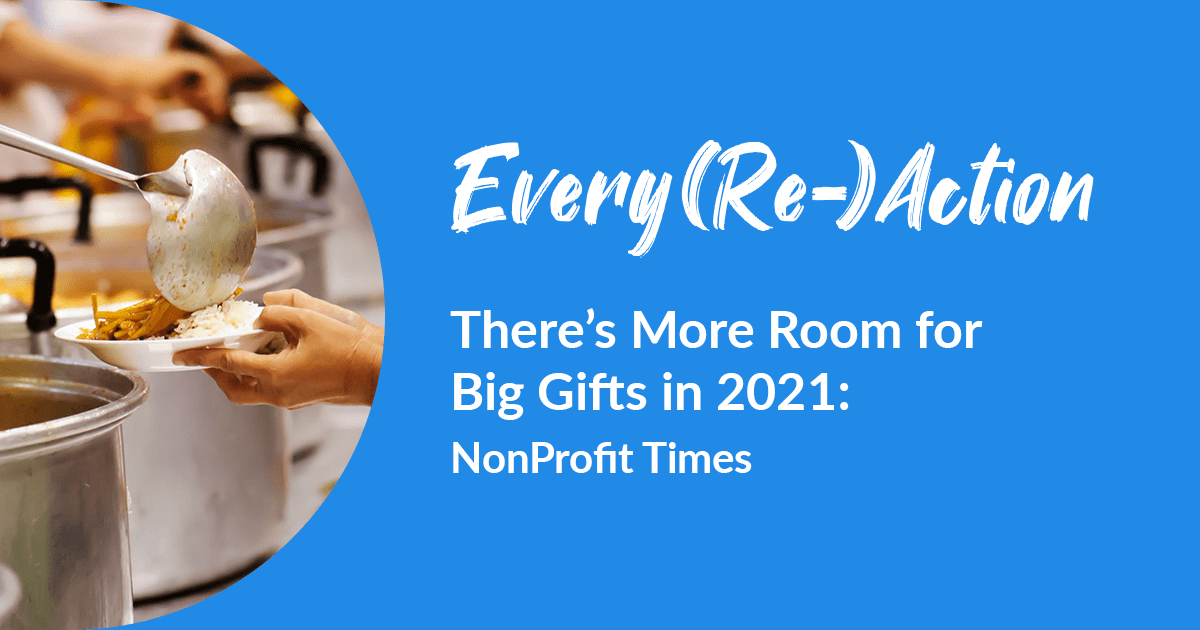Every(Re)Action | There’s More Room For Big Gifts In 2021: NonProfit Times

Knowing that major donors had given generously in 2020, many nonprofits began this year questioning whether that pattern would continue as we entered 2021. The NonProfit Times has reported that a new study from Atlanta-based fundraising consultant agency Westfall Gold predicts nonprofits can continue to unlock major gifts this year—and that those gifts could range in size from $20,000 to six figures.
Westfall Gold reported a 21 percent increase in major donor giving between 2019 and 2020. It’s believed that this was “spurred, in part, by a robust stock market and strength in certain sectors of the U.S. economy despite higher unemployment and slowdowns due to the coronavirus pandemic.” Average major gifts rose by nearly $30,000, from $132,975 in 2019 to $162,437 in 2020.
Like many nonprofits do, the NonProfit Times says the report sorted major donors into categories according to their giving level:
Westfall Gold analysis breaks major donors into buckets based on their giving capacity. Buckets range from “B” level donors, who might be expected to donate between $20,000 and $39,999, all the way up to A++ (potential contributors of $400,000 to $1,999,999) and Mega donors, who could offer gifts of $2 million or more.
Some of Westfall Gold’s key findings included:
- Out of all of a nonprofit’s supporters with the ability to make major gifts, only 12 percent are currently doing so.
- Among those rated “A” donors or above (able to give gifts in excess of $40,000 during a two-year period), 88 percent have either lapsed or are contributing below their potential.
- The average contribution from a major donor (defined by the report as someone with “total giving of $25,000 or more, or largest gift of $10,000 or more ”) is $173,000.
- 29 percent of mid-level donors (those with “total giving of $2,500 or more or largest gift of $1,000 or more”) have the capacity to convert into major donors.
- 90 percent of major donors, and 98 percent of those who give $1 million or more, are willing to give unrestricted gifts—these are critically important to nonprofits seeking general operating dollars.
Recommendations for how nonprofits can take action based on those findings included:
- Don’t assume major donors will stop all giving in a stock market downturn. The report says, “Major donors respond with greater generosity during market upturns, but their giving does not drop by the same magnitude during market downturns.”
- A “multi-prong strategy” is best for increasing the major gifts nonprofits receive. Make bigger asks from current major donors, and cultivate mid-level donors who may have “tested out” an organization with a smaller initial gift before investing in a major gift.
- Reactivate donors who haven’t given recently based on look-alikes in your donor file.
- When you make an ask of a donor, ensure that your appeals are operating on “a combination of intellectual, emotional and transformational levels.” Nonprofits should “reference [the] overall mission and vision as opposed to specific projects.”
- Transformational appeals, or asks that “emphasize the differences a gift can make,” will require deep attention to detail and compelling visuals, like video and engaging storytellers.
Our Take:
Nonprofits who want to diversify their revenue streams to include more major donors will need the ability to predict which donors are good candidates for major giving, plus the ability to predict the best times to ask them for a bigger commitment—in other words, you need intelligence you can act on. Organizations also need a foundation of reliable, unified, real-time data, otherwise you risk acting on inaccurate predictions. Seeing every bit of your supporter data in one place can help you make your goals a reality.


